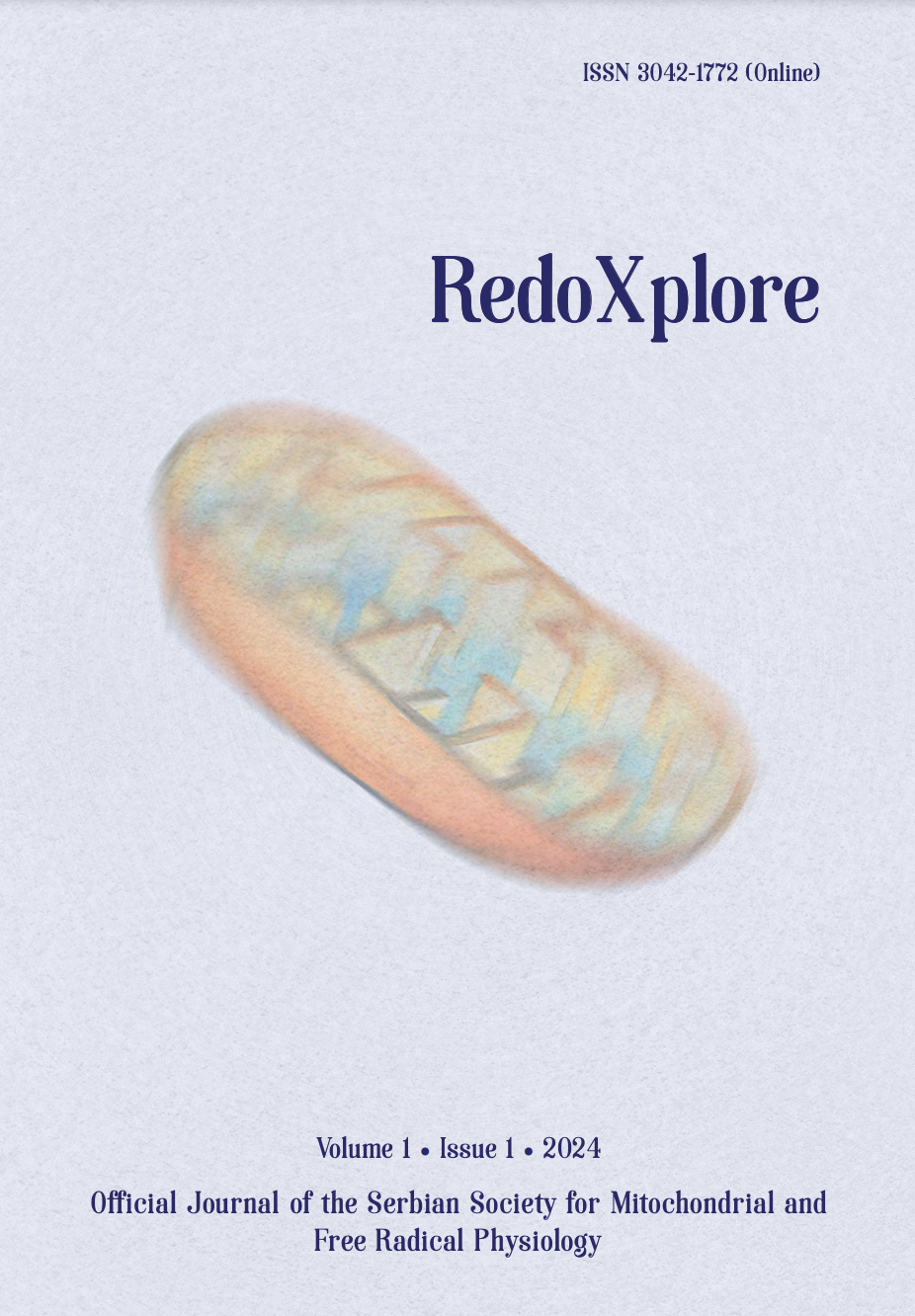
More articles from Volume 1, Issue 1, 2024
REDOX AND METABOLIC REPROGRAMMING OF BREAST CANCER CELLS AND ASSOCIATED ADIPOSE TISSUE - THE CORNERSTONES OF ADAPTIVE TUMOUR BEHAVIOUR
INSULIN MODULATES MITOCHONDRIAL STRUCTURAL AND FUNCTIONAL MOSAICISM IN BROWN ADIPOCYTES
NITRITE MITIGATES OXIDATIVE BURST IN ISCHEMIA/REPERFUSION IN BRAIN SLICES
NITRIC OXIDE, SUPEROXIDE AND PEROXYNITRITE – REDOX REGULATION OF THE CARDIOVASCULAR SYSTEM BY NITRO-OXIDATIVE STRESS AND S-NITROS(YL)ATION
DIETARY NITRATE AS PIVOT ON THE GUT MICROBIOTA-HOST REDOX COMMUNICATION
DIFFERENTIAL SPATIAL DISTRIBUTION OF SYNTHETIC NANO- AND MICRO-PARTICLES EXPLAINS THE EFFECTS ON CARDIOVASCULAR FUNCTION – IMPLICATIONS FOR AIR POLLUTION HEALTH EFFECTS
Department for Cardiology 1, Molecular Cardiology, University Medical Center of the Johannes Gutenberg University Mainz , Mainz , Germany
Partner Site Rhine-Main, German Center for Cardiovascular Research (DZHK), , Mainz , Germany
Department for Cardiology 1, Molecular Cardiology, University Medical Center of the Johannes Gutenberg University Mainz , Mainz , Germany
Mainz Animal Imaging Center (MAIC), Leibniz Institute for Resilience Research , Mainz , Germany
Atmospheric Chemistry Department, Max Planck Institute for Chemistry , Mainz , Germany
Department for Cardiology 1, Molecular Cardiology, University Medical Center of the Johannes Gutenberg University Mainz , Mainz , Germany
Department for Cardiology 1, Molecular Cardiology, University Medical Center of the Johannes Gutenberg University Mainz , Mainz , Germany
Department for Cardiology 1, Molecular Cardiology, University Medical Center of the Johannes Gutenberg University Mainz , Mainz , Germany
Department for Cardiology 1, Molecular Cardiology, University Medical Center of the Johannes Gutenberg University Mainz , Mainz , Germany
Department for Cardiology 1, Molecular Cardiology, University Medical Center of the Johannes Gutenberg University Mainz , Mainz , Germany
Department for Cardiology , Molecular Cardiology, University Medical Center of the Johannes Gutenberg University Mainz , Mainz , Germany
Department for Cardiology 1, Molecular Cardiology, University Medical Center of the Johannes Gutenberg University Mainz , Mainz , Germany
Partner Site Rhine-Main, German Center for Cardiovascular Research (DZHK) , Mainz , Germany
Center for Thrombosis and Hemostasis (CTH), University Medical Center of the Johannes Gutenberg University Mainz , Mainz , Germany
Department of Clinical Chemistry, University of Ulm , Ulm , Germany
Multiphase Chemistry Department, Max Planck Institute for Chemistry , Mainz , Germany
Department for Cardiology 1, Molecular Cardiology, University Medical Center of the Johannes Gutenberg University Mainz , Mainz , Germany
Partner Site Rhine-Main, German Center for Cardiovascular Research (DZHK), , Mainz , Germany
Atmospheric Chemistry Department, Max Planck Institute for Chemistry , Mainz , Germany
Department for Cardiology 1, Molecular Cardiology, University Medical Center of the Johannes Gutenberg University Mainz , Mainz , Germany
Center for Thrombosis and Hemostasis (CTH), University Medical Center of the Johannes Gutenberg University Mainz , Mainz , Germany
Division of Cardiology, University Hospital, Department of Medicine III, Goethe University Frankfurt , Frankfurt am Main , Germany
Mainz Animal Imaging Center (MAIC), Leibniz-Institut for Resilience Research (LIR) , Mainz , Germany
Institute of Pathophysiology, University Medical Center of the Johannes Gutenberg University Mainz , Mainz , Germany
Atmospheric Chemistry Department, Max Planck Institute for Chemistry , Mainz , Germany
Department for Cardiology 1, Molecular Cardiology, University Medical Center of the Johannes Gutenberg University Mainz , Mainz , Germany
Partner Site Rhine-Main, German Center for Cardiovascular Research (DZHK) , Mainz , Germany
Department for Cardiology , Molecular Cardiology, University Medical Center of the Johannes Gutenberg University Mainz , Mainz , Germany
Partner Site Rhine-Main, German Center for Cardiovascular Research (DZHK) , Mainz , Germany
Center for Thrombosis and Hemostasis (CTH), University Medical Center of the Johannes Gutenberg University Mainz , Mainz , Germany
Editor: Bato Korac
Published: 29.08.2024.
Selected oral presentations
Volume 1, Issue 1 (2024)
Abstract
Particulate matter (PM) air pollution presents a major environmental and public health challenge because of its non-uniform size distribution and chemical composition. Air quality regulations generally categorize particulate matter (PM) size into PM10, PM2.5, and ultrafine particles (UFPs) with aerodynamic diameters smaller than 10, 2.5, and 0.1 µm, respectively. We examined the differential impact of particle size per se on selected organ systems using a custom whole-body mouse exposure system using synthetic PM (SPM). The micrometer-sized SPM accumulated in the lungs as the primary entry organ, while ultrafine SPM showed less accumulation, implying a transition into circulation. Micro SPM-exposed mice exhibited inflammation and NADPH oxidase-derived oxidative stress in the lungs. Ultrafine SPM-exposed mice did not show oxidative stress in the lungs but rather at the brain, heart, and vasculature levels. Endothelial dysfunction and blood pressure increase were more pronounced in ultrafine SPM exposed mice, supported by increased endothelin-1 and decreased endothelial nitric oxide synthase expression, enhancing constriction and reducing vasodilation. To derive a preliminary estimate of the cardiovascular disease burden of UFPs in humans, we used new high-resolution exposure data at a global scale, and applied hazard ratios from an epidemiological cohort study. We derived a UFP-associated incidence of 419 (95% CI 78–712) thousand cardiovascular disease cases per year in the European Union and 5.6 (95% CI 1.1–9.3) million globally. This work provides novel insights into the different toxicological profiles of inhaled ultrafine particles and public health consequences of exposure, guiding future studies.
Citation
Copyright

This work is licensed under a Creative Commons Attribution-NonCommercial-ShareAlike 4.0 International License.
Article metrics
The statements, opinions and data contained in the journal are solely those of the individual authors and contributors and not of the publisher and the editor(s). We stay neutral with regard to jurisdictional claims in published maps and institutional affiliations.






